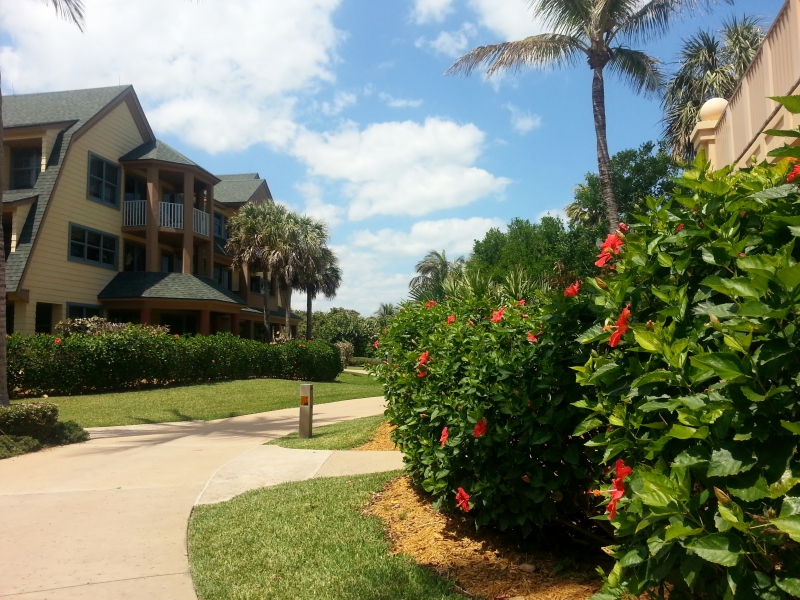Crinum lilies are tough, low maintenance plants that bloom prolifically on lengthy, succulent stalks. In Zones 9 and up, they typically flower from early spring through midsummer and sporadically during the rest of the year. I noticed the cluster below on Easter Sunday while we were Brunching (yet again ❗ it’s the BEST!) at Disney Vero Beach Resort. Even when their flowers have withered, Crinums create an architectural focal point in the landscape.
While exploring the Disney Resort’s grounds, I ran across a group of signs I’d missed on previous occasions. Clever advertising, yeah?
Following the sign towards the beach, I passed this pretty hibiscus lined road:
Here’s a close-up view of a fully opened flower:
As you can see from the foliage and blooms, this is a very healthy specimen: not all hibiscus have been this lucky
In June, 1992, an invasive insect known as Pink Hibiscus Mealybug was discovered in Broward County, Florida and has continued spreading upwards throughout the state.
The Pink Hibiscus Mealybug (PHM) sucks juices from its host plant, injecting toxic saliva as it feeds. This process leads to the malformation of leaves and fruit, as well as stunted leaves and terminal (tip) growth, which is commonly called “bunchy top.” PHM affects species beyond ornamentals. The list is staggering: citrus, avocado, fig, guava, mango, and sugarcane; vegetable crops including asparagus, beans, beets, cabbage, peanuts, pigeon pea, cucumber, lettuce, pepper, pumpkin, and tomato. Even forest trees are at risk of harboring this hungry pest!
With this in mind, the USDA has declared April, Invasive Plant Pest and Disease Awareness Month. Invasive pests and diseases are non-native species that cause – or are likely to cause – harm to the economy, the environment or human health. The USDA stresses that the more people know about hungry pests, the more they can do to stop them.
Go to www.HungryPests.com to learn more, and get involved on Facebook at www.facebook.com/hungrypests.
Until next time….
🙂 🙂 🙂
Related articles
- Hibiscus flower (ajaytao2010.wordpress.com)
- The meaning of a Hibiscus (hellosommer2013.wordpress.com)
- Habiscus (projectventuragarden.wordpress.com)
- Spread the Message, Not the Pests (fldpi.wordpress.com)
- Invasive pests cost Americans millions (usatoday.com)
- Asian beetle pest eradicated from Canada (cbc.ca)
16 thoughts on “Crinum Lilies, Hibiscus, and Invasive Pest Awareness Month!”
Comments are closed.






Nice reading about you
Thanks for visiting my blog Ajaytao2010@wordpress.com. Browse through the category sections, I feel you may definitely find something of your interest.
You are so very welcome Ajay! I swear by using the Zemanta links! Without them I might never have discovered your blog!
Also, let me thank YOU for subscribing here and taking time to leave comments on my previous posts. I appreciate it very, very much.
thank you very much Karen, your blog and your pics were both superb, I really loved them both
you dedicated your life to a beautiful cause that is according to exceptional
thank you so much
As far as I know we don’t have a huge problem, because of the climate I suppose.
Hi Gilly!
You’re right: cold stress is a limiting factor for PHM, a pest native to tropical Asia. There are infestations in Egypt and India but not elsewhere in Europe from
what I can see after doing a bit of research.
I found a good site for tracking more likely European Invasive Pests (you prob know about it already!): European and Mediterranean Plant Protection Organization
Hibiscus always remind me of a lovely holiday I once had in Lanzorate. They grow in abundance there.
Bridget.
I love Disney World….special times. My dad has a huge hibiscus plant in his garden in Illinois. I can’t believe how big the blossoms get.
They really do get huge! there’s a pink variety in the landscaping around the local Outlet Mall that measure more than 12in!
Your photos are great fun, Thank you for sharing.
Thanks Charlie! 🙂
I’ve kind of got it down now. I know what times of day work best for getting shots at different spots around the yard. 🙂
This was a nostalgic post for me. My grandparents and aunt lived in Vista, CA, and every few years we’d take Amtrack to visit them at Christmas. Oh, but the bright colors of amaryllis and hibiscus in bloom, and they even had orange and grapefruit growing in their back yard. For a Kansas girl, this was like walking into a make-believe world!
I’ve ALWAYS wanted to take Amtrak cross country….flying is so boring, but there’d be interest and variety watching the USA glide by from the window of a train….or at least that’s how I imagine it. 🙂
Your description of your grandparents’ property sounds beautiful…CA has that wonderful Mediterranean climate so perfect for fruit trees. When my ex was joining his first practice we spent a week in and around Riverside (CA) that coincided with orange blossom time…..the air was SO redolent and soft it was pretty remarkable!
Oh, don’t get me started on the emerald ash borer.
Thanks for the info-graph. I just secured my new home and I have a garden! So I’m looking forward to planting again and I do remember the pests!